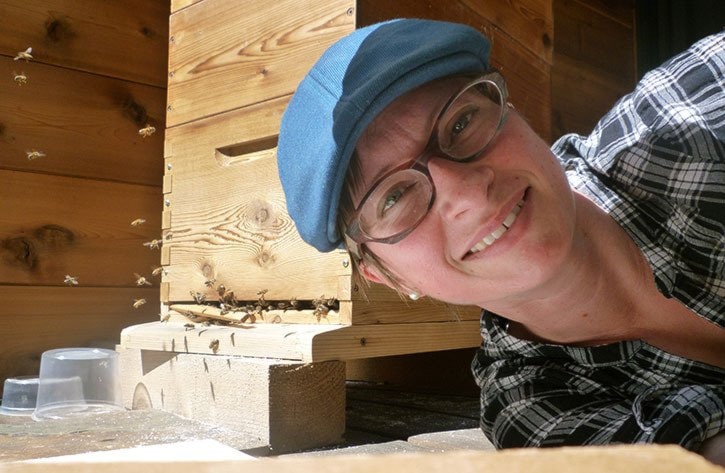Beekeepers are being encouraged to watch for 'zombie bees' after the first confirmed parasite-infected honeybees in Canada were found in Lantzville.
Researchers at San Francisco State University confirmed a parasite that infects and kills honeybees – after first causing disoriented, zombie-like behaviour – was found in Canada by local beekeeper Sarah Wallbank.
It might sound like a scene out of a Hollywood movie, but the parasite and its attack on honeybees is a phenomena tracked by John Hafernik, professor of biology at San Francisco State University and ZomBee Watch, a project that has citizen scientists collect samples of the parasite to see how widespread it is in North America. This is the northern-most example of the fly parasite, he said.
The fly is native to North America, but Hafernik said it’s normally found in bumblebees and yellow jacket wasps. He suggests the attack on honeybees is relatively new.
The fly deposits eggs into the abdomen of the bee, which hatch and feed and shortly after the bee will leave its hive, fly toward the light, acting disoriented and zombie-like.
It’s not something local beekeepers have heard before, but B.C.’s head apiarist, Paul van Westendorp, advises them not to be concerned.
“Really quite frankly I will advise [beekeepers], tell them straight out don’t be concerned as long as you make sure that you have healthy colonies, strong colonies, colonies that are looked after," Westendorp said. "I don’t believe that there is going to be any serious threat concerning phorid flies that may parasitize a few bees. It’s totally inconsequential.”
Wallbank, a Lantzville resident, started to notice the behaviour of her bees four to six weeks after getting her hive. Bees were attacking her porch light.
“When you think about a moth flying around a light, the mother is paying attention to the light and fluttering around it,” she said. “Bees that are affected, they smash themselves into the light. They just hit it. It’s like linesmen in football, like bang, bang, bang – over and over again.”
They don’t move like they have control of their limbs properly, it’s slow and painful to watch, she said.
Research led her to believe she might be looking at the parasite, and the ZomBee Watch website showed her how she could collect samples with a light trap. A phorid fly expert at the Natural History Museum of Los Angeles County confirmed her bees had been infected by the parasite behind zombee infestations, a university press release shows.
Wallbank doesn’t know why she has the zombie bees, and said she feels the tragedy of the situation.
“It’s a really bad way to go in my opinion,” she said.
She hopes to encourage other local beekeepers to set up light traps and take samples to see how far spread the parasites are.
Hafernik also hopes people are observant, especially beekeepers on what’s happening with the bee to help understand the distribution of the phenomenon.
“They should be observant and try and see what’s happening with their beehives and see if there’s any evidence that they are infected,” he said, although he doesn’t believe beekeepers should panic.
It’s one of the many things honeybees are dealing with, he said, and the best thing beekeepers can do is keep their hives as healthy as possible, which would also keep bees resilient to things like flies and mites.
Westendorp, provincial apiculturist, also doesn’t see the need for concern. On a scale of 0 to 10, there are diseases and tests bees deal with like varroa mites, that are at a 10. The phorid fly is at a 1 or 2.
If the fly gets hold of a bee and successfully parasitizes it, it will lead to the death of the individual bee, but he said in the bee world it's not the individual bees they talk about but the integrity of the honey bee colony.
“Yes, from an academic perspective it’s interesting we have these little phorid flies out,” he said. “I would be alerted that if indeed this beekeeper is having this infestation and the phorid flies are that successful in parasitizing her bees, I have the suspicion or the concern that her colonies may be weak for other reasons and that’s what enables the phorid fly infestation to be successful.
“The larger picture of the phorid fly I don’t think is a problem.”
Stan Reist, co-owner of the Flying Dutchman, has been dealing with the virreau mite, which causes the greatest amount of grief. They are not aware of zombie bees.
“It might be something that happens and there’s not enough of it to twig onto it, but it’s just something else I’m going to have to watch for,” he said, adding he’s not concerned.
Peter Lange, president of Nanaimo Beekeepers Club, said they are in the process of gathering more information but do know the size of the problem is unknown, and that the fly isn’t dangerous to humans.
The club will monitor it, he said, and send information out to educate beekeepers, invite them to watch out for it and report it.
